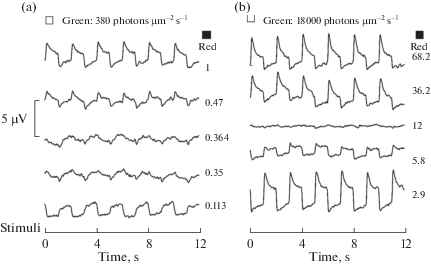Журнал эволюционной биохимии и физиологии, 2020, T. 56, № 7, стр. 792-792
Photoreceptors of River Lamprey L. Fluviatilis: the “Color Vision” Paradox
A. Yu. Rotov 1, *, L. A. Astakhova 1, D. A. Nikolaeva 1, M. L. Firsov 1, V. I. Govardovskii 1
1 Sechenov Institute of Evolutionary Physiology and Biochemistry of the Russian Academy of Sciences
Saint Petersburg, Russia
* E-mail: rotovau@gmail.com
Introduction. The river lamprey retina contains the so-called short and long photoreceptors (PR), functionally similar to rods and cones, respectively. It was found that both types of PRs are able to work together in daylight, potentially providing color vision (Govardovskii & Lychakov, 1984). To explain this phenomenon, it was suggested that short PRs are able to avoid saturation in the photopic range of intensities. Later, however, it was shown that they are actually saturating in response to short flashes of light at moderate intensities, similar to typical rods (Asteriti et al., 2015). This study purpose is to find a new explanation for the “color vision” paradox.
Methods. The responses of lamprey’s single PRs to prolonged background exposures were recorded by the suction pipette method. PRs of a marsh frog served as control “typical rods”. The effect of “color vision” was studied by alternating green and red-light stimuli for preparations of lamprey’s isolated retina and eyecups (light substitution colorimetry).
Results. Saturation of photoresponses of lamprey’s single short PRs, unlike long PRs, occurs at the same background intensities as for the frog rods. Light substitution colorimetry showed the presence of color discrimination at moderate intensities of alternating stimuli. However, when the brightness of the green stimulus is established at a short PRs saturation level, it becomes possible to select the intensity of red that leads to a “silent substitution” (see Fig. 1).
Fig. 1.
Color substitution experiments on lamprey’s isolated eyeball. 1-s steps of green and red light are quickly interchanged, as shown by the stimulus mark at the bottom of each panel. Intensity of red is expressed in arbitrary units and shown near each trace. (a) Intensity of green is fixed at a moderate level, and the intensity of red was decreased from top to bottom. No “silent” substitution was possible. (b) Protocol is repeated at the intensity of green 47 times higher. At a certain intensity of red stimulus, the response to color switching disappears (middle trace) evidencing activity of just a single photoreceptor type.

Conclusions. Adaptation of lamprey’s short PRs to background light (as in “typical rods”) leads to the existence of a range of intensities in which they work together with long PRs. The disappearance of the color discrimination effect after saturation of short PRs excludes the possibility of existence of more than one type of cone-like cells in lamprey’s retina. Thus, the paradox of “color vision” is explained by the presence of a mesopic range of illumination for two types of PRs.
Supported by RFBR 19-34-90182.
Список литературы отсутствует.
Дополнительные материалы отсутствуют.
Инструменты
Журнал эволюционной биохимии и физиологии


